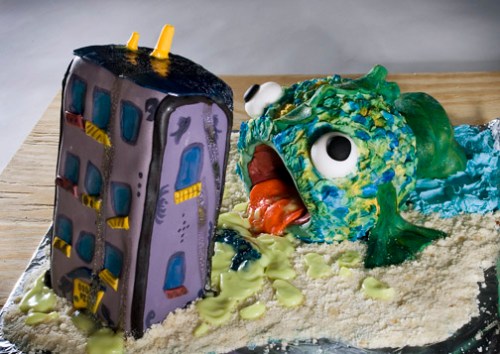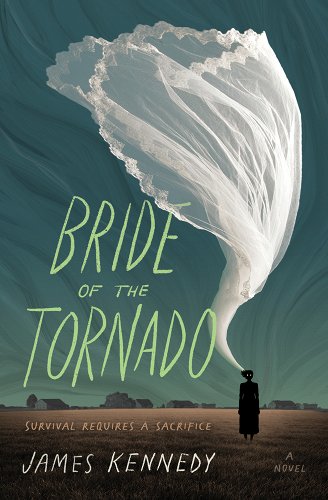[ad_1]
There’s no way to ease into this. I met James Kennedy in person while he was dressed as a tornado.
If your brain can stretch to imagine what that looked like and how it might be done, Kennedy’s new book, Bride of the Tornado, is for you.
With that particular Midwest experience of high winds and destruction turned into the horror novel’s monster, Bride of the Tornado is a high-velocity twister of a ride. It’s weird, but that’s exactly what James Kennedy wants you to think—and embrace, as “strong medicine.”
I asked James Kennedy a few questions about Bride of the Tornado (some of which he answered), yelled at him a tiny bit, and got to the bottom of what the heck-fire he is up to.

Lori Rader-Day
I’ve seen Bride of the Tornado described as “horror,” “American gothic,” “psycho-sexual,” and “coming-of-age.” Actually, that was all one review. ALL CAPS YELLING WHAT KIND OF BOOK IS THIS JAMES KENNEDY?
James Kennedy
Yes, I’m proud that the Daily Mail described Bride of the Tornado as “a super-storm of psycho-sexual intensity.” I’m sure my mother is proud too.
Bride of the Tornado tells the story of a small Midwestern town that, once a generation, is overwhelmed by a mysterious plague of sentient tornadoes. That’s right: SENTIENT TORNADOES—inscrutable air-monsters with vicious minds of their own. The town’s only hope is “the tornado killer,” a teenage boy banished outside city limits who has the strange power to punch, kick, and wrestle tornadoes into submission.
The main character is a girl who is fascinated by the tornado killer, and who discovers clues all over town that seem meant for her—and she also learns that the tornado killer is fascinated with her too. They enter into a dangerous relationship, and together uncover the occult connection between them. For the adults are hiding a secret about the tornadoes and the true nature of the tornado killer—and this girl must escape before the primal power that binds them all comes to claim her.
This book has clandestine cults, forbidden love, icky body horror, teenage angst, violent weather, small-town tension, and a creeping nightmarishness that breaks the boundaries between reality, fantasy, and memory. And I guarantee you won’t look at the musical Oklahoma! the same way again.
Actually, I think I covered much of this information much more efficiently at Bride of the Tornado’s book release party, when I dressed up as a tornado and sang the plot of the book to the tune of “Rock You Like a Hurricane.”
Lori Rader-Day
Where did this story start for you? Fever dream? Adult gummy overdose?
James Kennedy
I’ve never experienced the wrath of a full-on tornado, but growing up in Michigan, in the spring or summer you’d sometimes have a tornado warning. My family would hear the tornado alarms blaring, and we’d scurry down into the basement to wait it out. As a kid, something like that sticks out for you. When else did my entire family hide together as though cowering from some vast monster?
But a tornado is a monster, and a quintessentially American one—our country endures a thousand tornadoes a year, which is three-fourths of the tornadoes in the world! Like all monsters, a tornado is uncanny: an annihilating column of dark, angry, whirling air stretching to the heavens, a giant specter that materializes out of nothing, pulverizes everything in its path, and evaporates before you can catch it. And unpredictable: a tornado might destroy an entire town but leave one house unharmed. A tornado might hurl you for miles, or rip your clothes off, or kill you. When nature is this huge and sublimely violent, you can only run, hide, or submit.
Or maybe not? Some time after I had finished writing Bride of the Tornado, I read a newspaper article about how some Native American tribes have rituals to turn away a tornado’s wrath. The Wichita tribe has a ceremony that involves throwing an axe into the ground, intended to “split the storm” so it goes around their homes. The women of the Kiowa tribe speak to the tornadoes in their language, asking it for mercy. In 2013, the Cheyenne-Arapaho performed a ritual that seemed to cause the tornado barreling toward them to take a sharp turn away, sparing their homes. It was fascinating to learn about.
Back in the 1990s I had the idea of a boy who could kill tornadoes—a kind of swaggering, larger-than-life, Paul-Bunyan-like figure given to surreal braggadocio. But that idea didn’t go anywhere when he was the main character; the story only became interesting when the tornado killer was a distant mystery, and the main character was the person who was obsessed with him. Once I began to explore that relationship, all the details of their small town quickly fell into place—the friends and enemies, teenage rivalries, adult secrets, weird religions—and it was off to the races.
Lori Rader-Day
What’s your writing process like and which psychotropics are involved?
James Kennedy
Psychotropics? I always think of that line from The Simpsons when Otto the bus driver asks a writer, “Whoa! What were you smoking when you came up with that?” and the writer primly replies, “Rotisserie chicken.”
As for my process, I usually start writing in longhand—writing directly onto the computer skips too many steps for me. Everything looks too pretty and official when it’s typed out on the screen in a nice font . . . You’re tempted not to edit it! After I get a section written in longhand, I write it out again neatly. That forces me to edit it again. And then I finally type it in, which forces me to edit it yet again. I’ve written all three of my books like this. (It’s not a recipe for being a fast writer.)
Also, all three of my books started as short stories. The final novel always ends up being very different from the original short story, but the short story has the essential kernel of DNA that the novel expands upon and teases out over a longer span.
Finally, I read my stuff out loud to myself to edit it. Just walking back and forth in my basement, reading the pages and muttering to myself like a weirdo.
Lori Rader-Day
What question do you hope I ask you about Bride of the Tornado?
James Kennedy
I hope you ask, “What question do you hope I don’t ask?”
Lori Rader-Day
What question do you hope I don’t ask?
James Kennedy
If I genuinely hoped you don’t ask the question, why would I ask it of myself? (Man, I’m good. If I were Captain Kirk and you were a computer, you would have exploded by now.)
Lori Rader-Day
You’ve written for kids. You’ve written for adults. Who is the better audience and why?
James Kennedy
My first novel was a young adult fantasy called The Order of Odd-Fish, and the genuinely excited response from kids for that book was wonderful. When you write for kids, you get opportunities to visit schools to talk about your books and to meet young readers. That’s harrowing to introverted authors, but I loved it. It’s what I imagine doing stand-up would be like, except I suspect that winning over a group of seventh graders at 9 in the morning is harder than dealing with drunk hecklers at Zanies on a Saturday night.
Kids are still open to new ideas; it’s possible your book could become the favorite book of their youth, the book that they think about and return to again and again for the rest of their lives. (Even though it’s been fifteen years since Odd-Fish came out, I still get emails from kids and former kids who say how much they loved it, and requests for me to sign their old first-edition copies.) If you catch someone early enough, you can have a reader for life. That’s a powerful and beautiful thing.
Actually, Bride of the Tornado started out as a YA book, but my agent gently informed me that it wasn’t YA at all. I realized he was right. So I rewrote a lot of it to remove its YA-ness, and in that rewriting I felt the freedom to make it more intense, scary, and visceral, and that’s what truly made the story come into its own. Even still, there is some irreducible amount of YA DNA in Bride of the Tornado. That’s good too. There’s a push and pull.
As for writing for adults—it has its own satisfactions. But I do find that adults are more rigid and less imaginative. If you go down the WTF path, which is what I like best, you are going to alienate a certain number of adult readers who, on some level, don’t want to be challenged or surprised. It’s much easier to sell kids on weird stuff. That said, though, you can get weirder in an adult book. There are some scenes in Bride of the Tornado that no child should read.
Lori Rader-Day
You said kids send great fan mail. Have any great examples?
James Kennedy
Yes! I noticed that, after The Order of Odd-Fish came out, a lot of talented young people were making amazing fan art based on it. I collected that fan art here on my website. There are a lot of weird examples, but one of my favorites was this elaborate cake based on a scene in the book where a fish heaves itself out of the ocean and barfs up a building onto a beach.

When you get an outpouring of cool stuff like this, it’s not enough to say “thanks” and move on. How to properly respond to all this creativity?
So in response, I worked with Chicago’s Collaboraction Theater Company to put on a real-life gallery show of that fan art. But it wasn’t just an art show—it was also a costumed dance party and sacrificial ritual. About three hundred people came, including many of the artists, some from many states away. People came dressed up to the gallery as characters and god-monsters from the book, and we organized an elaborate dance competition that went late into the night, culminating in a ceremony in which the winner of the competition was “sacrificed” to the gods. Good times!
Here’s what one of those battles looked like.
Lori Rader-Day
What has the response to Bride of the Tornado been so far?
James Kennedy
The response has been intense but strangely consistent. The phrases I hear again and again are “fever dream” and “nightmare you can’t wake up from.” But different people have different tolerances for this kind of strong medicine. You get some people who post five-star reviews that say, “What the hell did I just read?” but you get other folks who post one-star reviews that say, “What the hell did I just read?” They all say that Bride of the Tornado is super weird; they just have varying reactions to dealing with this level of weirdness.
And that’s where I want to be, culturally. If I read a book or watch a movie, and it goes down too easily, I forget it pretty quickly. It ends up not mattering much to me. The stories that have stayed with me and changed my life are spiky, hard to digest, and alienating. For me, good stories pull you in with one hand while they push you away with the other.
Not everyone likes that. But indeed, my favorite reviews are the ones where, even when they’re trying to give you a bad review, they can’t help but end up complimenting you. I’m thinking of this one-star review I found on The Storygraph which goes:
“I hated the experience of reading this book so much that I suppose it’s a recommendation. It’s self-consciously weird, violent at exactly the wrong times, gross when it doesn’t need to be, and the cat situation was unacceptable. It was also well constructed, well written, well plotted, with characters who a reader can care about. You’ll love it, assuming you are a terrible person.”
That last sentence is everything. I want it printed on the cover of all future editions of the book.
Lori Rader-Day
For the promotion of Bride of the Tornado, you have worn a tornado costume to speak as the character of the sentient tornado in the book. I don’t even know what to ask here. “Why?” doesn’t seem to get to the point. Explain yourself, sir.
James Kennedy
Yes, at the American Library Association conference in Chicago this year, I showed up in a homemade tornado costume in the character “Tornado Jeff,” whom I claimed was a co-star of Helen Hunt and Bill Paxton in the 1996 movie Twister. The joke was I gave Tornado Jeff a job being an extra in Bride of the Tornado.
You see, nowadays Tornado Jeff is an unemployed tornado who can’t get the roles he used to. CGI tornadoes have put him out of work, and now the only jobs he can get are children’s birthday parties and bar mitzvahs. “Everyone wants to see you pick up the cow and throw it around,” Tornado Jeff sighs, fondly remembering his Twister glory days. “But how often can you do that before people want to move on? . . . I’m just spinning around in the corner, nobody’s even paying attention, kids are on the dance floor twerking to Cardi B.” It’s tough out there for a freelance tornado, so I threw him a bone.
Be careful, though—Jeff is touchy about Sharknado and next year’s upcoming Twister 2 (he didn’t even get a call). Don’t bring that up. You can watch the speech here.
Lori Rader-Day
You run the 90-Second Newbery Film Festival. Can you talk about its origin and your vision or goals for it?
James Kennedy
Sure! The 90-Second Newbery Film Festival is an annual video contest I founded in 2010 in which kid filmmakers create short movies that tell the stories of Newbery-winning books in about 90 seconds. (The Newbery Medal is the highest honor in children’s literature.) Weird takes are encouraged: Charlotte’s Web in the style of a horror movie, for instance, or A Wrinkle in Time done as a musical.
Every year we have big gala screenings of the best of these kid-made movies in cities all over the US—not only in Chicago, but also in New York; San Francisco; Boston; San Antonio; Minneapolis; Salt Lake City; Oakland, California; Rochester, New York; Tacoma, Washington; Ogden, Utah, and other cities. These screenings are attended by hundreds, and I co-host them with other known well-children’s authors.
If you have or know a kid who is interested in filmmaking, this is a wonderful project (and adult help is okay, by the way). The national deadline for movie submissions is January 26, 2024. You can learn more about the 90-Second Newbery at http://www.90secondnewbery.com.
And just in time for the spooky season, here’s that horror version of Charlotte’s Web I mentioned above, made by some kids from the Schaumburg Township District Library a few years ago.
You can see more of the best 90-Second Newbery movies I’ve received right here.
Also, save the date: on March 9, 2024, we’ll be screening the 13th Annual 90-Second Newbery Film Festival at the Harold Washington Library Center downtown, hosted by me and fellow kids’ author Mary Winn Heider (The Stupendous Switcheroo and more). I promise it will be weird and wonderful!


James Kennedy is the author of the middle-grade novel The Order of the Odd-Fish (2008), the adult sci-fi thriller Dare to Know (2021), and the adult horror novel Bride of the Tornado (2023). He is the founder and director of the 90-Second Newbery Film Festival. Before becoming a writer, he was a software engineer with a degree in physics and philosophy, subjects he continues to explore in his writing.

FICTION
Bride of the Tornado
By James Kennedy
Quirk Books
Published August 15, 2023

[ad_2]
Source link

